I have something of a bag obsession. I know all sorts of specs and fabric details for so many bags from so many random companies, and finding a bag that manages to distinguish itself from the masses is always a cause for celebration. This is why I was so annoyed that no one had ever told me about Tom Bihn, because it seems like all their bags do that, and they’re practically down the street from me.
One of their flagship travel bags is the Aeronaut, which is designed to be the only travel bag you need, and one you can take with you on any flight, or check through without worrying; a duffel bag that can be carried multiple ways, and can be organized far more efficiently than pretty much any other duffel bag out there. I included it on my list of travel backpack recommendations, and now that I’ve got my hands on one (Tom Bihn sent me a free sample to test out), we’re going to enjoy a super thorough review.
So here we go, with the Tom Bihn Aeronaut 30:
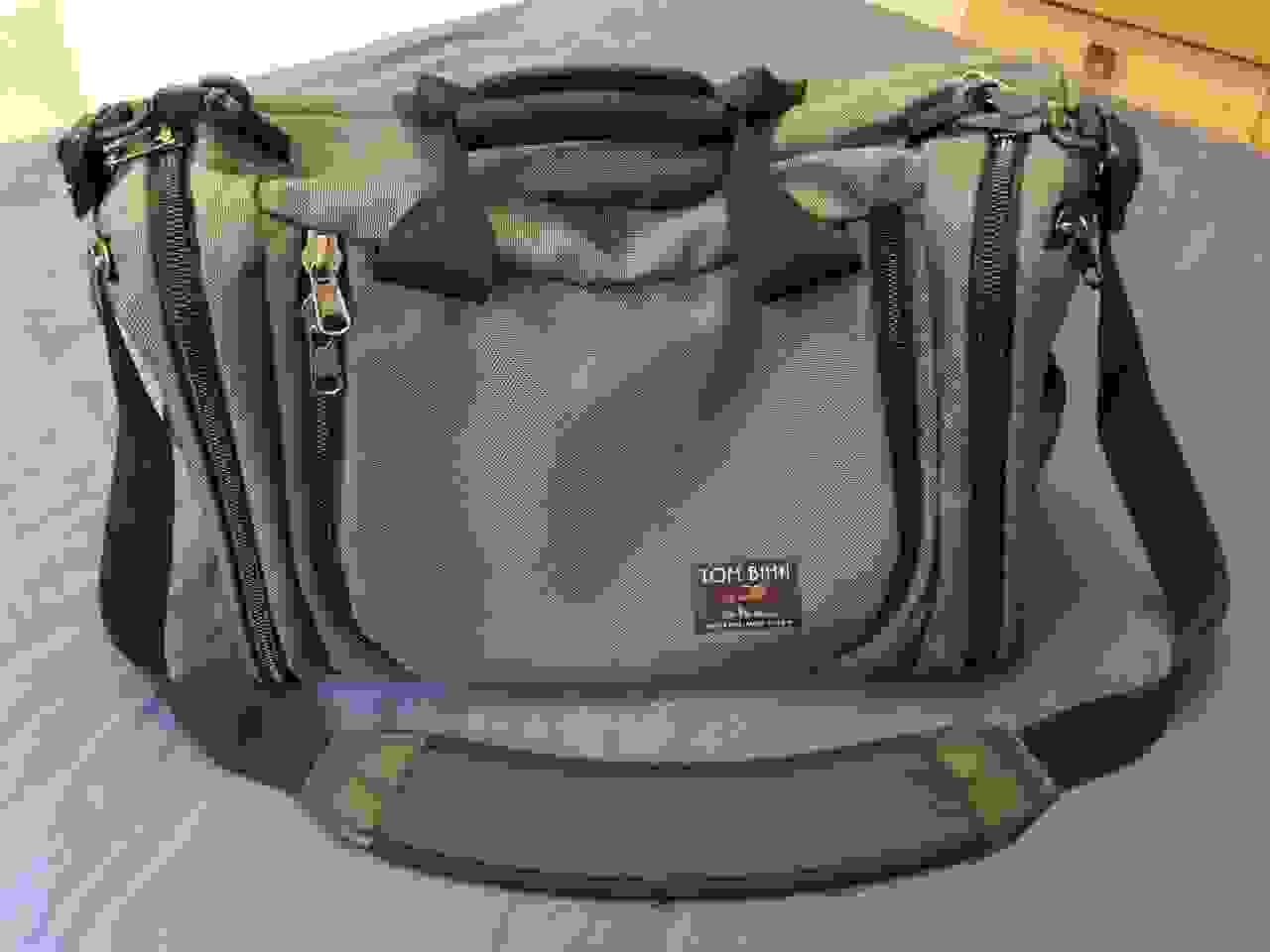
It’s a highly versatile, convertible duffel bag, going back and forth between duffel bag and backpack mode, and optimized for air travel, but useful for all sorts of other things as well.
Specs:
The Aeronaut comes in two different sizes; 30 liters, or 45. The 45 liter version was the original variation, designed to fit the maximum-sized carry-on dimensions of most major airlines, whereas the 30 liter version is designed to accommodate the more stringent requirements of smaller, no-frills European carriers.
I would expect that most…normal people will prefer to travel with the 45 liter version, as it simply provides more capacity, and, due to the compartmentalized design, is also easy to under-pack, as we shall discuss shortly…although the 30 is great if you just want a smaller bag for whatever reason.
Specs for the Aeronaut 30:
- Price: $270
- Capacity: 30 liters
- Dimensions: 19.7 x 12.6 x 7.9 inches (500 x 320 x 201 mm)
- Weight: 2 lbs, 14 oz (1.3 kg) for the ballistic nylon version, or 2 lbs, 5.6 oz (1.06 kg) for the Dyneema version.
Specs for the Aeronaut 45:
- Price: $280
- Capacity: 45 liters
- Dimensions: 22 x 14 x 9 inches (555 x 355 x 230 mm)
- Weight: 3 lbs, 1 oz (1.39 kg) for the ballistic nylon version, or 2 lbs, 7 oz (1.09 kg) for the Dyneema version.
(Both versions have exactly the same set of features; one is just the big brother version of the other, so although this review will specifically show the 30 liter version, the info is applicable to both.)
Comparing perhaps the best travel duffel bag…with the worst
For a while I had trouble thinking about how best to approach this, as the design is so self-explanatory that it seemed almost superfluous to discuss its oh-so-obvious features; but there are just so many minor details, many of which might be entirely overlooked, and under-appreciated…until you try something else, in which case the Aeronaut’s advantages would become immediately apparent.
So, instead of comparing the Aeronaut to a list of well-crafted contenders (almost all of which suffer from the same design problems anyway), I am instead going to conduct a side-by-side comparison with another duffel bag I own, which, as I’m sure you’ll agree, is the worst duffel bag in the history of the world:

This is, ironically, my oldest possession. I received it as a gift at the age of 13, and nothing else I own even comes close to matching the numerous chapters of my existence that this ancient survivor has overseen. Not because it’s good, mind you; it’s terrible. I brought it into the Tom Bihn factory to show them just how much of an upgrade I was getting. But it’s just another bag, so it comes in handy whenever I have to move, so there’s no reason to throw it out. Besides, it has my name embroidered on it. That makes for awkward gifting.
Of course, it’s clearly unfair to compare a high-quality duffel bag with a terrible one; we all know who’s going to win. But the design features of the terrible duffel bag are so frighteningly common in 99% of designs that comparing them directly against each other is going to highlight just how problematic those decisions can be, especially for air travel, which is something the vast majority of duffel bags are simply not properly designed to handle…particularly when it comes to qualifying as a carry-on.
It often helps to study a broken system to understand how to do things correctly, so I intend this to be not just a review of what’s going on with the Aeronaut, but also a simultaneous critique of the vast majority of duffel bags, and their many, glaring, travel-related deficiencies, which will become immediately obvious when placed side by side with something better. Let’s begin:
Layout and organization
This is perhaps the most obvious feature; as you can see, the Aeronaut is split into multiple compartments, whereas most duffel bags have just a single zipper, servicing a massive, disorganized, cavernous interior:
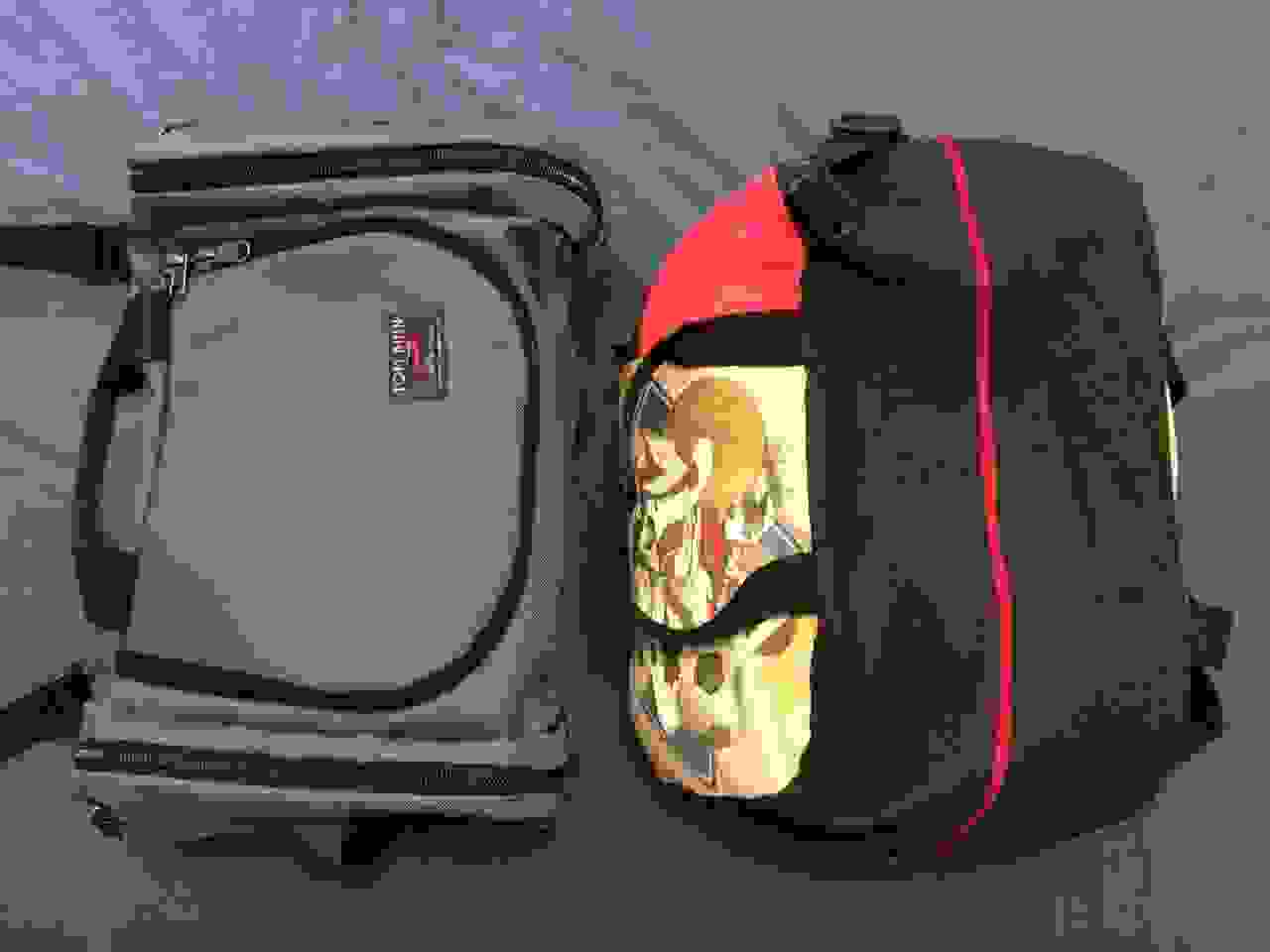
It’s pretty obvious that dividing the bag into multiple sections makes it a million times easier to stay organized, but it also makes it easier to under-pack (you can fill up just one or two sections without worrying about items banging around in the empty space, without the need for compression straps), and it makes it easier to pack to its maximum capacity (as the zippers go along multiple axes, and open more fully).
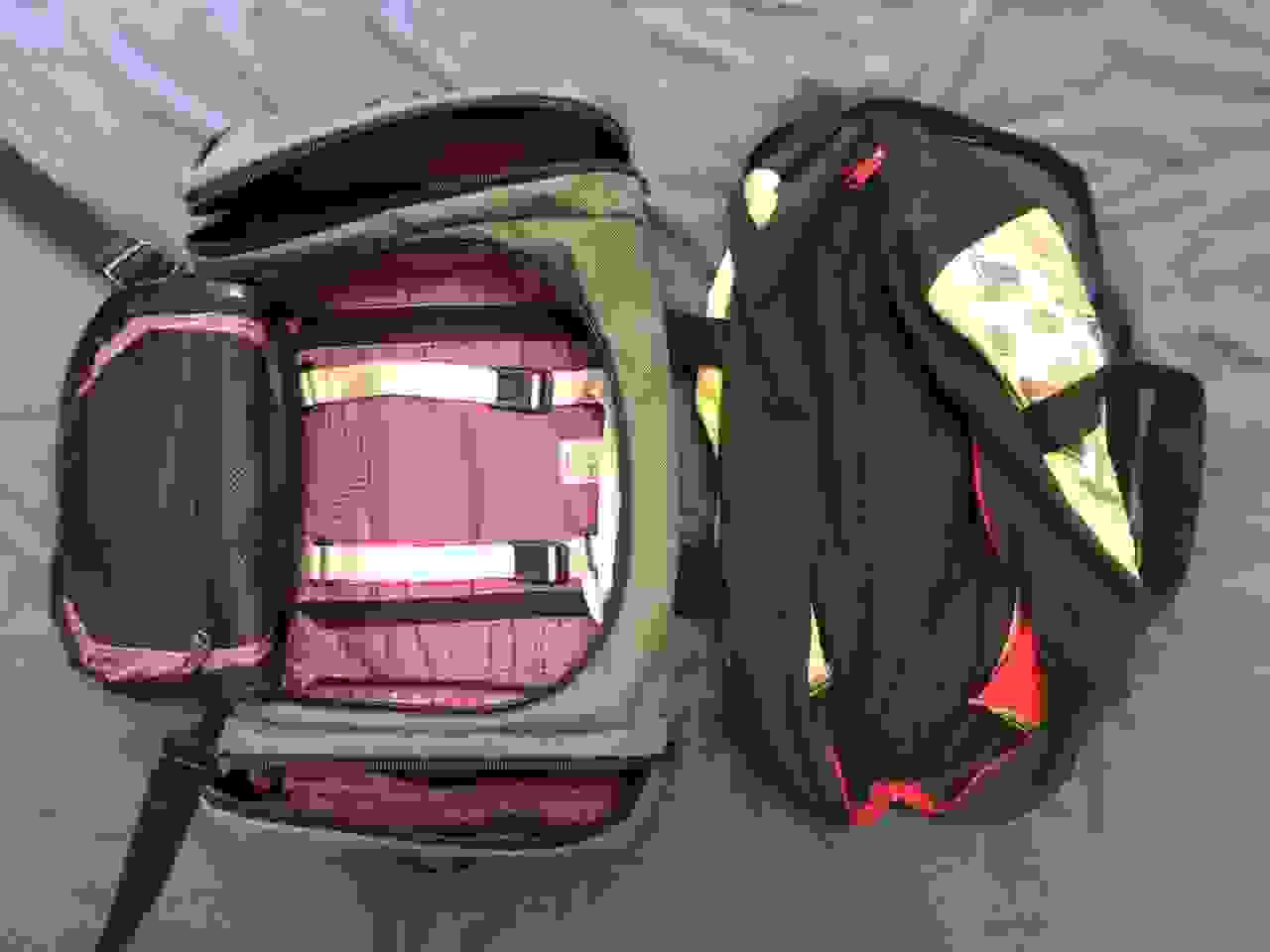
Trying to fill up a single-straight-line-zipper duffel bag to its maximum capacity is extremely difficult, because a standard duffel bag (when viewed from above) is rectangular, whereas the zipper opens in a diamond shape (because it’s a straight line stretched at the middle), which is exactly as annoying as it sounds. It’s also nearly impossible to find anything buried just a few inches deep without unpacking quite a few items, which can be rather annoying, due to the aforementioned diamond vs. rectangle issue. The more you have to pack and unpack, the more annoyed you’ll get…whereas the Aeronaut has none of these problems.
This is, however, a pros and cons scenario; a single zipper servicing the entire bag is easier to open and close quickly, as you just yank a single zipper in a straight line instead of opening multiple zippers with multiple angles; the speed is potentially helpful (and you can access it while standing), but then of course you have to live with the downside of poor organization, and the difficulties of packing and unpacking when you need to fill the bag to its maximum capacity. Single-straight-line-zipper duffel bags are at their best when they’re only partway full, with just a few bulky items, rather than lots of tiny ones.
But if you’re traveling, maximizing the use of space while simultaneously keeping things conveniently organized is the only way to go. There are going to be a million moments when you want to grab that one tiny thing, and digging around through a single, gigantic compartment is just going to drive you insane. And if you’re flying with strict luggage size limitations, “leave it half empty” just doesn’t work.
This is one of the major reasons why the Aeronaut functions as a really great duffel bag for air travel, as it allows for compartmentalized organization, efficient use of space, and easy packing and unpacking.
Here’s a closeup:
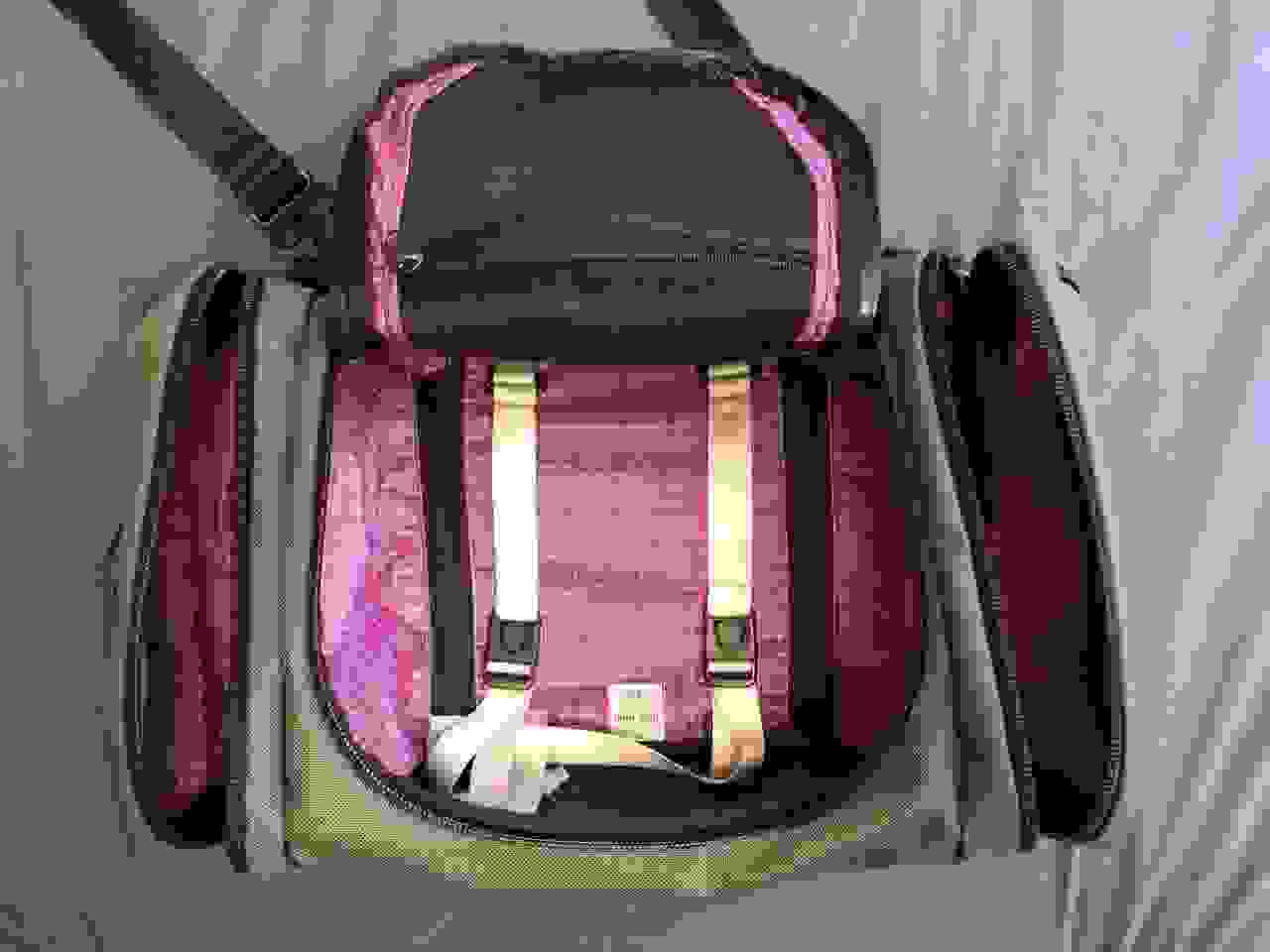
There are several things worth mentioning here; first of all, the ballistic nylon fabric and other elements actually provide some structure, so the bag doesn’t just flop over when it’s empty, so it’s easier to pack; secondly, the main flap barely takes up any room when open, whereas a standard suitcase door can be somewhat bulky if not propped up against a wall; thirdly, every one of those zippers is water-resistant, so you can haul it through the rain without much trouble.
On the inside, you’ll find some extra features, like the extra mesh pocket, and the (removable) straps that can be used to hold certain items in place, and the zippered divider walls that can be unzipped to turn the bag into a single, giant compartment, in case you need to carry something too long to fit into just the central chamber:
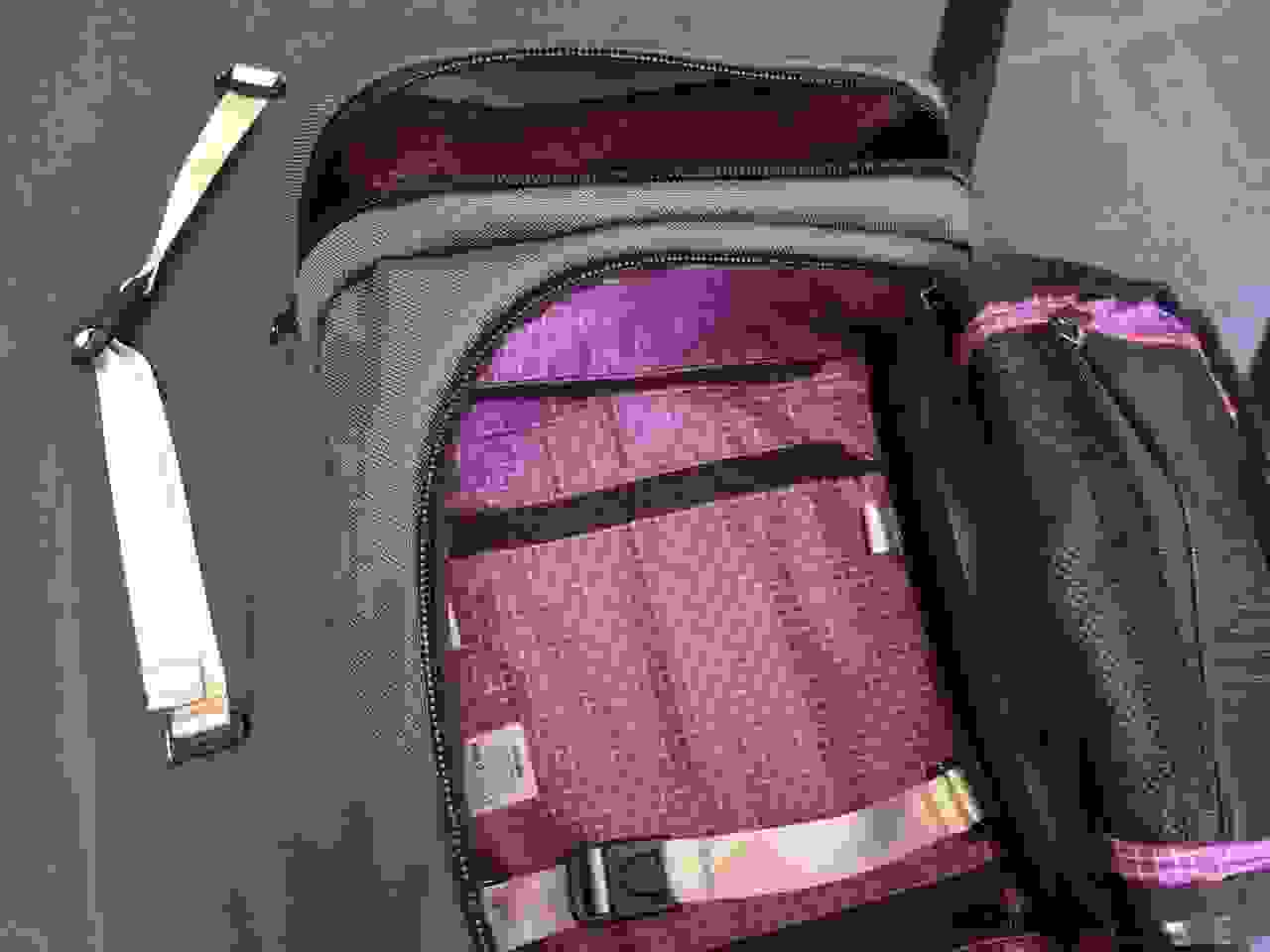
It doesn’t quite turn the bag into a single giant rectangle, though; it’s a bit more like a trapezoid. This is a bit difficult to describe, but it means you’ll still access the upper edges with those end-pocket zippers, rather than trying to get at them from the main zipper, which is offset far enough that it would get a little tricky at maximum capacity.
Speaking of end pockets, there’s an additional, zippered drop-in pocket on each end:
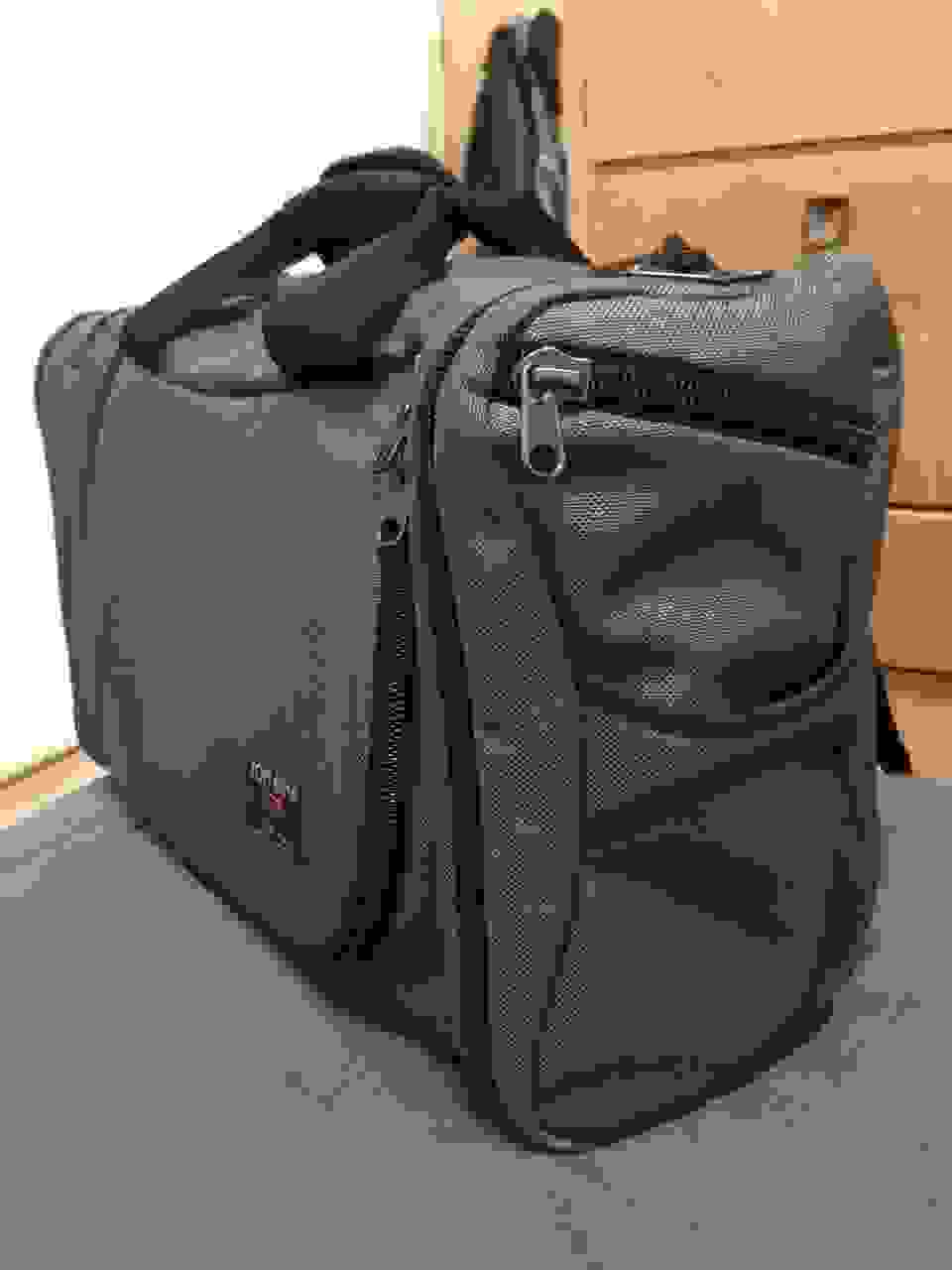
These end slots are good for long, skinny things that you might need quickly, like boarding passes, pens and pencils, or maybe a phone.
One of those slots also includes a removable key strap, for clipping all sorts of things into the bag:
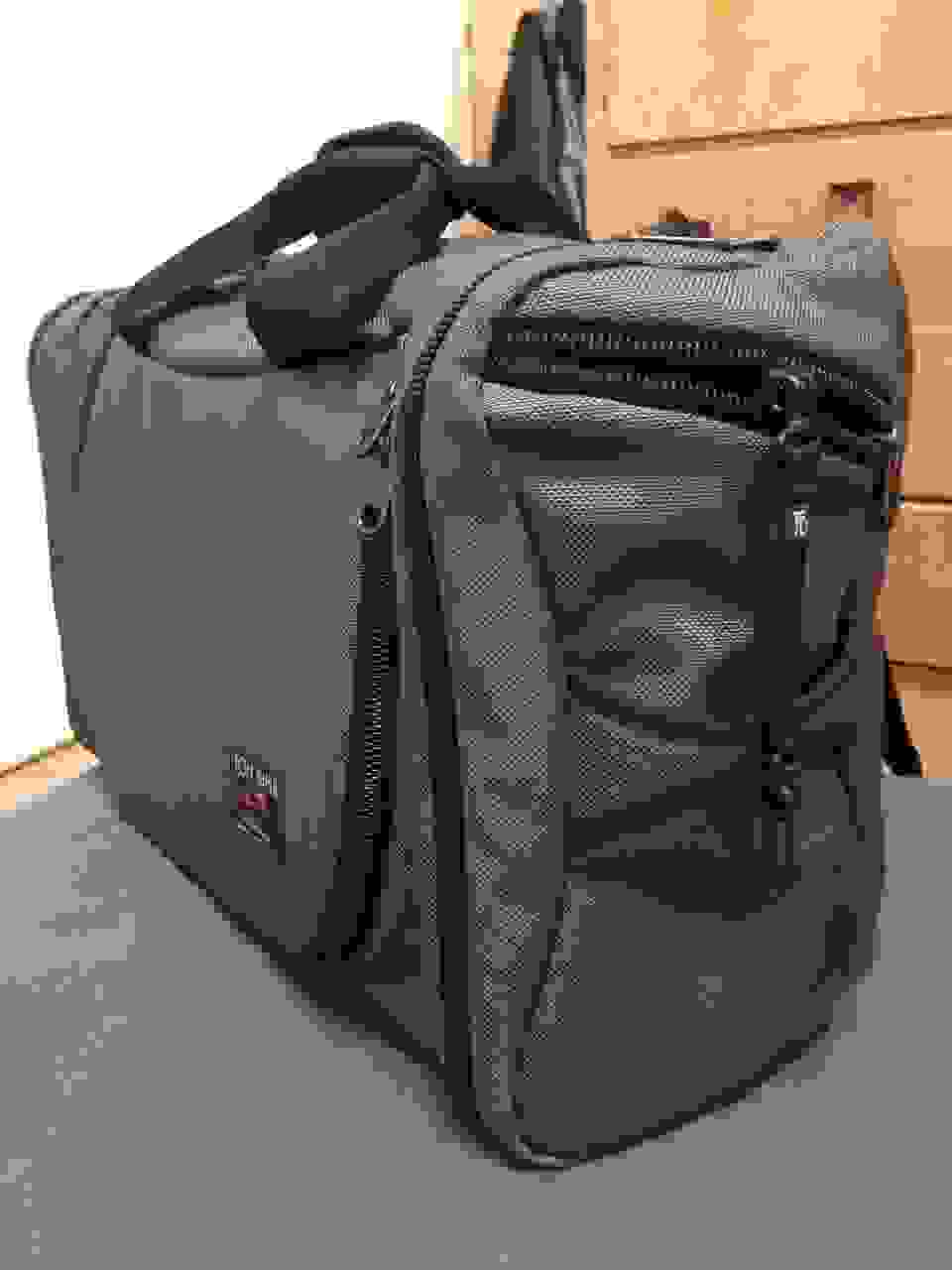
This is another reason Tom Bihn fans end up collecting the whole set; every bag has several attachment rings hidden among the compartments (I found nine in this bag), so you can clip tiny items all over the place. They never fall out, and they’re always exactly where you left them.
This is useful not just for small items like keys, but also other, smaller bags, such as the clear-sided 3-1-1 liquids container required by airlines, and other organizers. Just about every Tom Bihn bag is designed to work this way; the little bags clip into the big ones, and everything stays together. It’s quite convenient for keeping things from falling out and rolling under a bed in a hotel on the other side of the planet, for example.
Another major feature is simply the shape:
Air-travel optimized dimensions and features
Here’s another reason why the vast majority of duffel bags are terrible travel bags:

Most are either squared or cylindrical, which is simply not a good use of space in the overhead bin. They’re nowhere close to meeting carry-on dimension requirements, so you’ll probably have to check the bag, unless it’s incredibly small. And no matter how many times I’ve heard people complain about their bag not showing up when they arrive, they never bother attempting carry-on only travel…but oh well.
The Aeronaut, on the other hand, fits exactly within standard carry-on dimensions; the 45 liter version for major airlines, and the 30 liter version for smaller European budget carriers, meaning you’ll most often be able to bring it along with you. And, as far as I’m concerned, that’s the only way to travel.
And since you can stow it in the overhead bin, isn’t it convenient how it has those little grab handles on each end?

It’s not just easier to remove, but also easier to insert into the bin, because you’ve got something to hold onto as you shove it up there, so it’s harder for it to fall over.
Speaking of handles…
Multiple carrying options
This is a major strength of the Aeronaut, as it can be carried in three different ways, depending on how you want to handle things.
Main grab handle:
Take a good look at how the Aeronaut’s main handle compares to the obviously terrible, floppy straps of the other one:
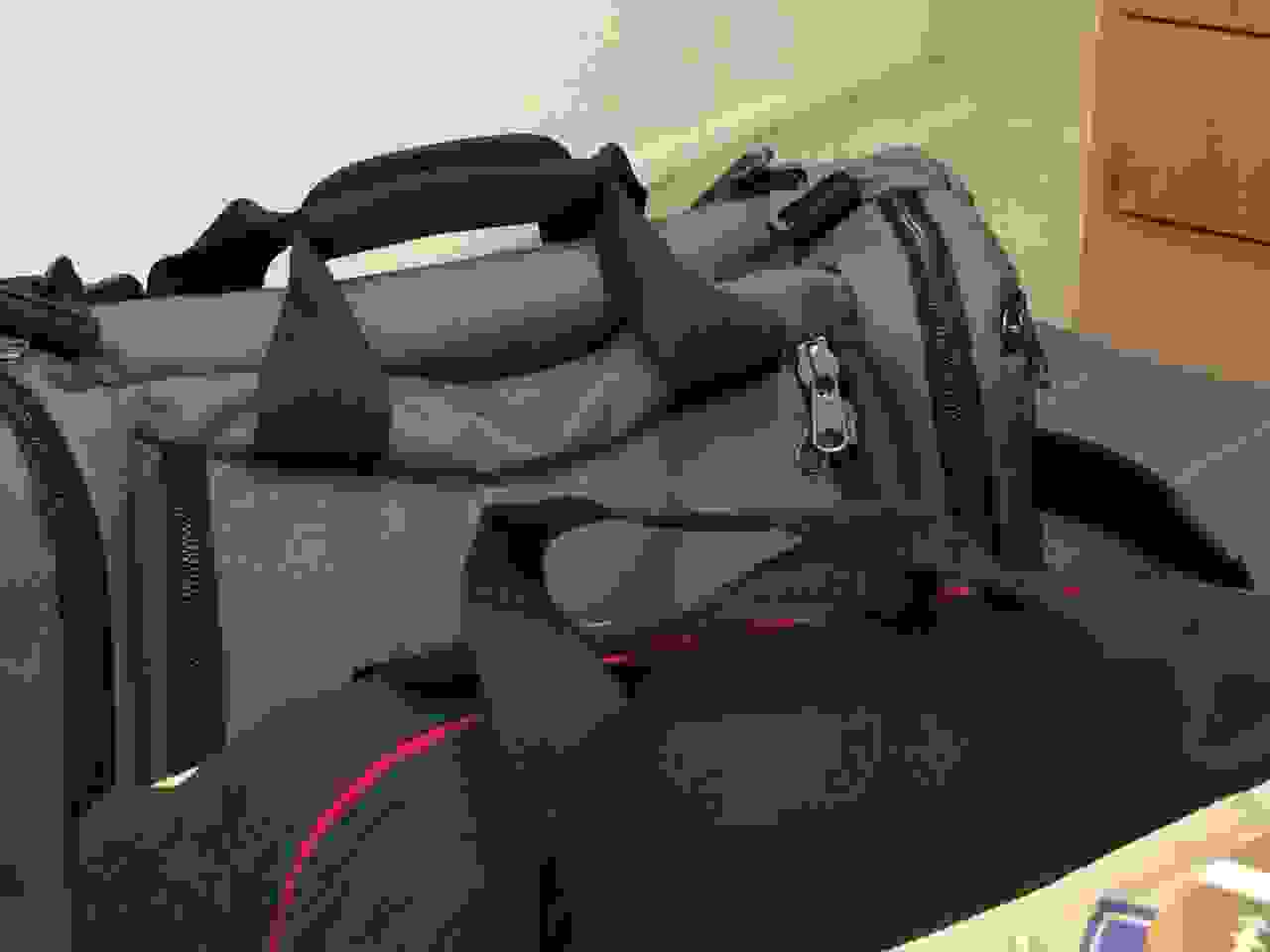
It’s so clearly superior as to be self-explanatory, but there are actually so many things worth mentioning here that I’m resorting to bullet points:
- It’s padded, making it more comfortable to carry, both in terms of cushioning and easy-to-hold size.
- It has a fixed shape (rather than the floppy straps of cheap bags), making it easier to grab, and more comfortable.
- The handle brings two separate straps together, making it a little more stable to carry; many other bags share this feature, but on the Aeronaut they snap together, so you don’t have to fumble with multiple floppy straps.
- The zippered main compartment is completely offset, meaning you never have to unsnap the main carrying handle in order to access any part of the bag. It’s just always together, always out of the way, and always ready to go.
Most other designs have two entirely separate handles which flop all over the place, and it sometimes becomes a two-handed operation to grab them (and imagine if your other hand is busy carrying another bag, or a small child). And even if they do snap or Velcro together, they’re quite often directly over the main zipper, meaning you have to unsnap them to access the bag, and then re-snap them when you’re ready to go. Or you could just leave them flopping around separately, but then you’re stuck with the first problem.
In contrast, the Aeronaut’s main grab handle is a lot easier to deal with, because you simply don’t deal with it. Life is just going to be a little easier, and when it comes to air travel, everything should be easier.
The shoulder strap:
Tom Bihn has a dearly-beloved, optional shoulder strap upgrade ($30 extra), known as the Absolute Shoulder Strap, which just about every review will recommend; it’s not included with the bag (it comes with a more conventional strap, with a sliding shoulder pad), but everyone adores it, especially when it comes to heavier bags, such as fully-loaded luggage that you’d take on a plane:
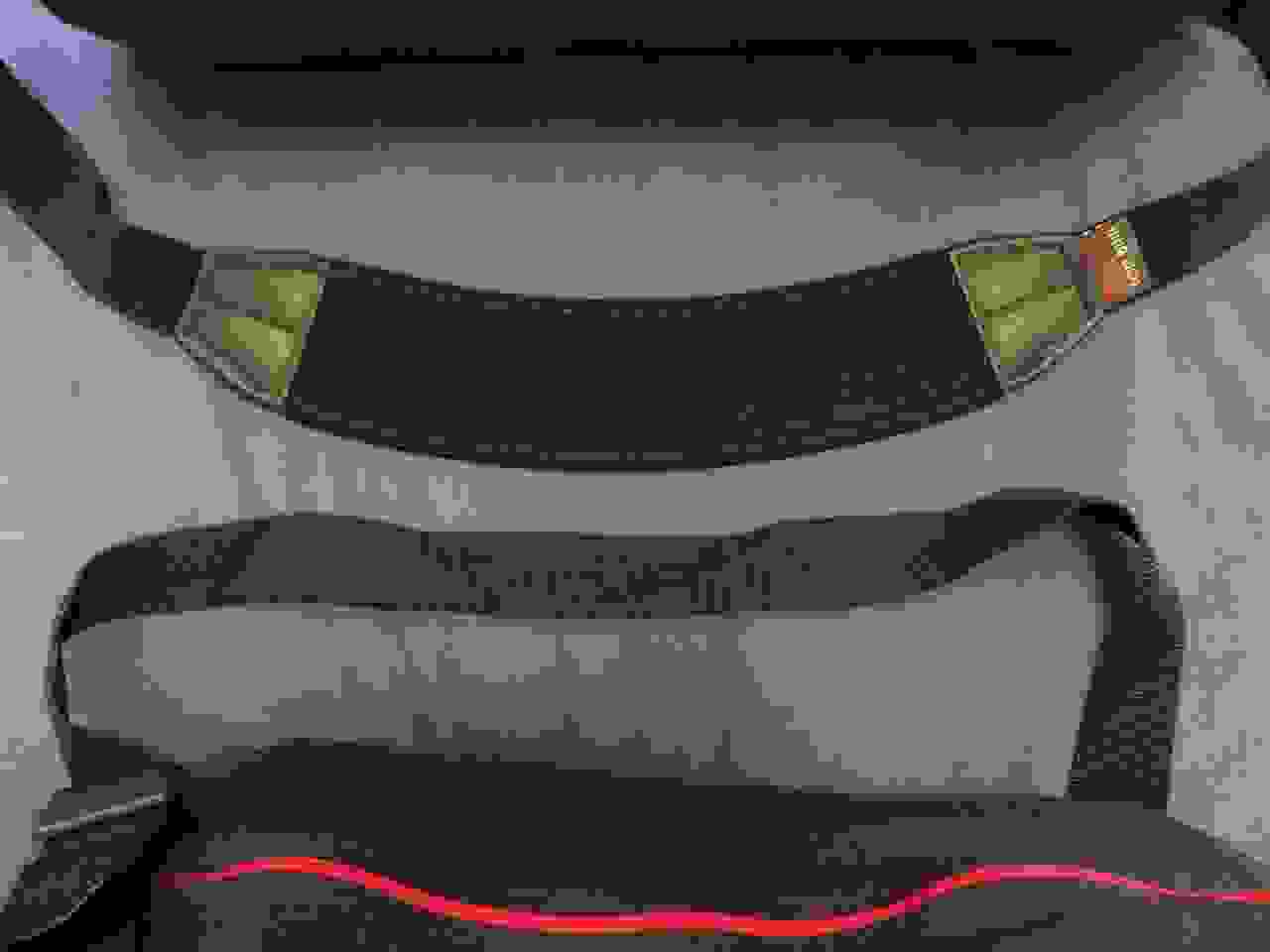
Bullet points again:
- It’s padded, which obviously makes it more comfortable.
- The padding is fixed into place (you adjust the strap length on each side, rather than just one), so you never have to slide the padding into position, which is something you have to do with most other straps. I love this particular feature.
- It has a grippy, non-slip surface on the side that rests against your shoulder, so it stays put.
- It’s curvy, meaning it’ll fit on your shoulder more appropriately than a straight strap.
- It’s actually stretchy. This is something I’ve never seen before, and I expect is a big part of the reason everyone loves this strap so much. Whenever you take a step and the bag bounces up and down, the stretchy shoulder strap works like a shock absorber, reducing the discomfort of carrying the bag over long distances (just be sure to adjust the strap when the bag is full, as the stretch makes it hang lower).
The strap is also long enough (at least on me) that I can adjust it to hang low enough that the grab handle is at the perfect height for hand-carrying, and thus I can distribute the weight between one shoulder and the opposite hand, to make it more comfortable to carry. Shortening the strap so you can loop your forearm through the main grab handle accomplishes the same thing, though I prefer the other way.
Backpack straps:
As mentioned, it can also convert to backpack mode. Here’s the back panel, where the backpack straps are hidden away when not in use:
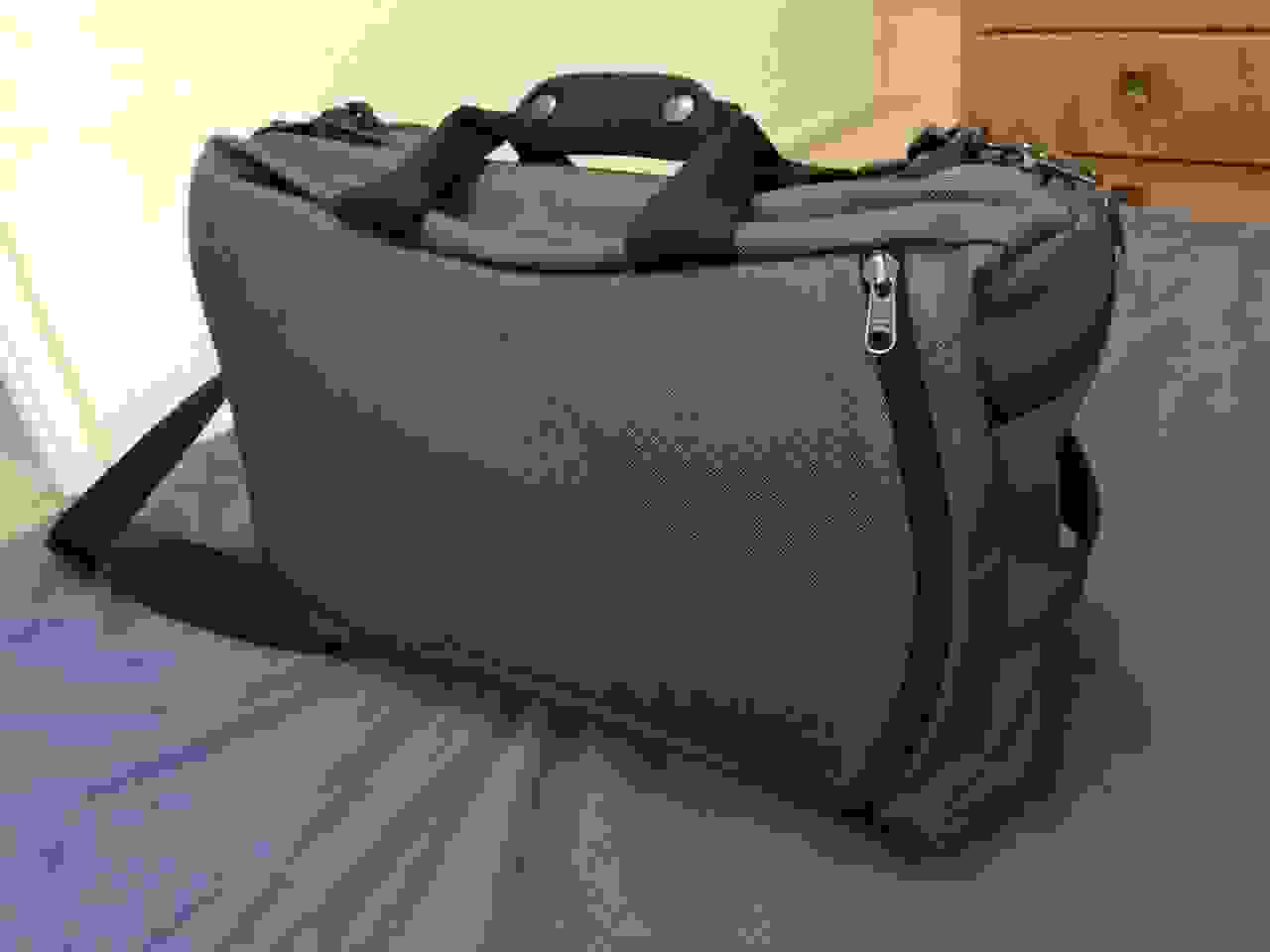
And here they are on the way out:
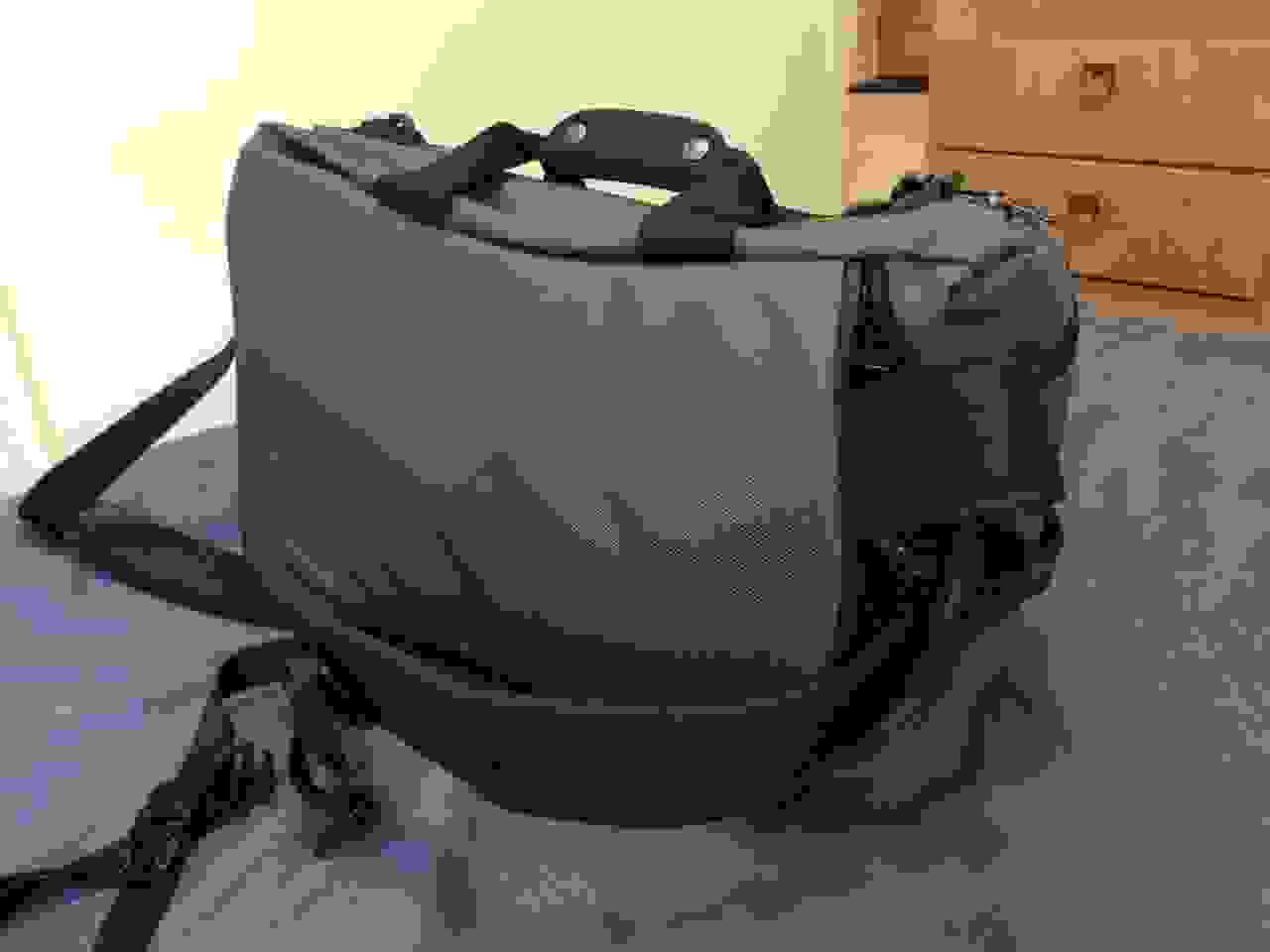
So it looks like this:
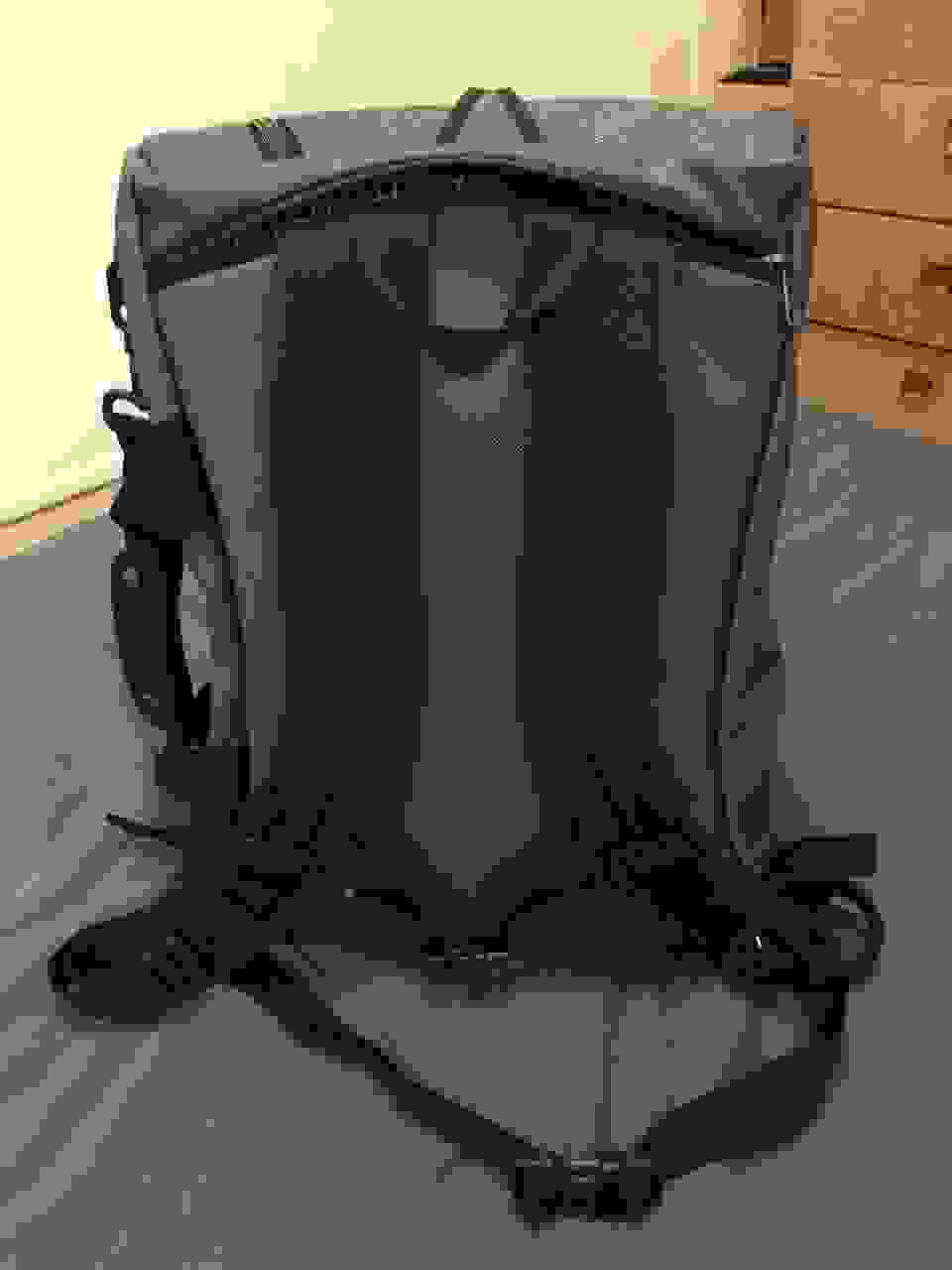
The backpack straps are identical to the ones used on their “real” backpacks, which I find quite comfortable, mainly due to the fact that they curve outward at the neck, rather than gouge into it, which is an oddly common problem with a lot of backpacks…even those with amazingly good reputations.
Another important thing to notice is that although the backrest is padded, it’s covered with the same fabric as the rest of the bag, rather than featuring visible mesh cushioning, like most “real” backpacks. This improves the aesthetics and durability, since there’s no exposed mesh to get snagged, but it’ll probably feel a little less breathable as a result, so it’s probably better to use them over shorter distances.
By the way, notice how you didn’t see the clips where the backpack straps attach; that’s because they’re completely hidden away in a recessed chamber:

Not only is this more aesthetically pleasing (to me, anyway), but it also means there won’t be any extraneous clips flopping around haphazardly to get stepped on, or banged around by other suitcases being shoved into the overhead bin, so it’s nice that they’re hiding like this; I’ve seen no other bags with this particular feature. But the clips are still easily accessible, as there’s plenty of room on either side of the clip to operate them. It’s a flat chamber, not a tiny one.
There’s another feature here that’s important; this is a closeup photo, so it’s hard to see what’s what, but it’s the waist strap (the horizontal one) clipping into a fabric loop that’s sewn directly into the backpack strap (the vertical one):
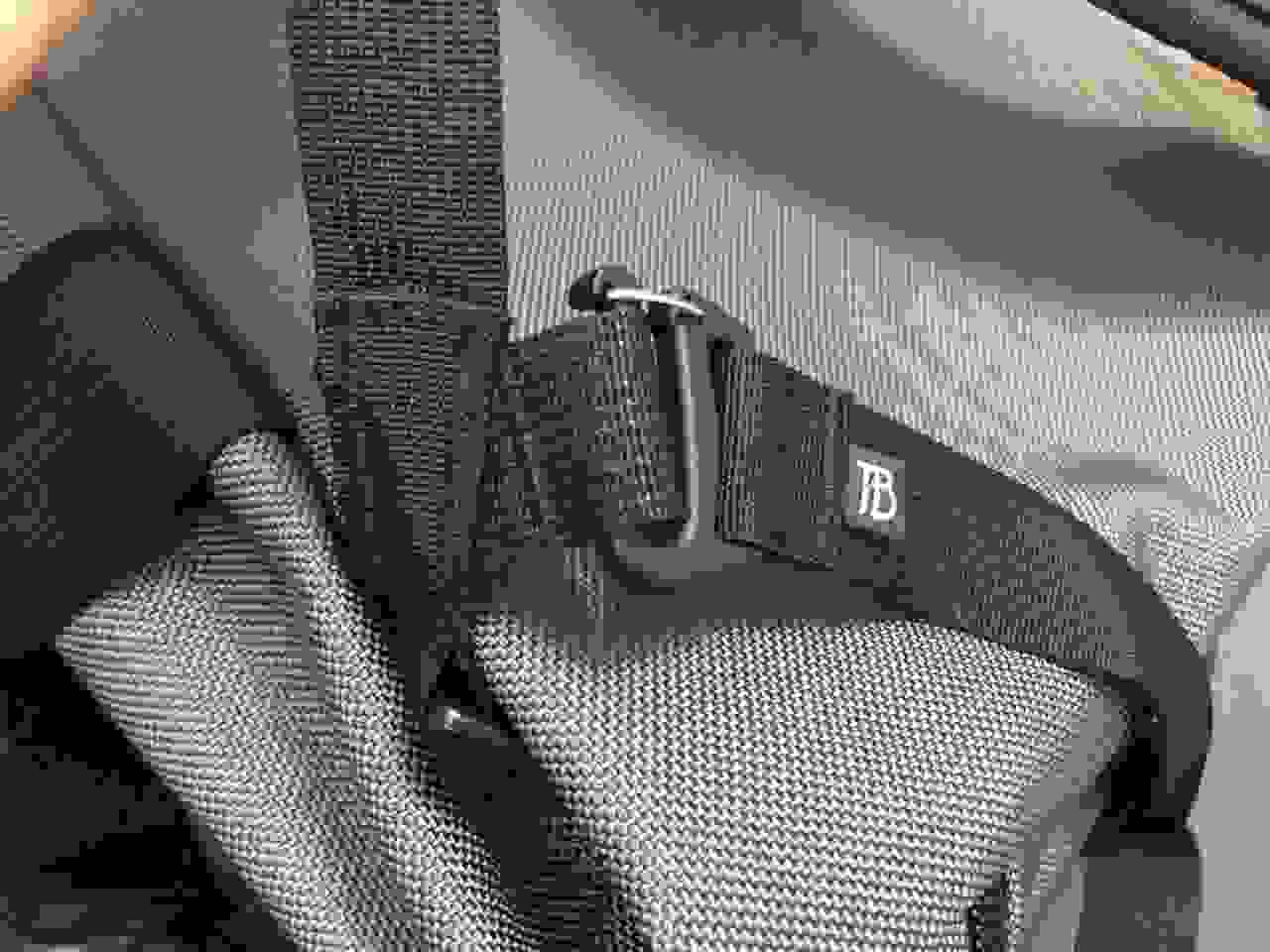
This means that when you stow or deploy the backpack straps, you still only have to deal with two clips, regardless of whether you’re using the waist strap or not; since the waist strap doesn’t have its own separate attachment point fixed to the exterior of the bag, it doesn’t require any additional steps, making it quick and easy to switch back and forth between backpack and duffel mode: Just one zipper, and two clips.
It does, however, mean the waist strap fits higher than on “real” backpacks; it’ll go over the stomach, instead of the waist (on me, anyway). It’s hard to say if this is objectively problematic or not, but I expect that taller people will think it’s sitting too high, whereas short people might think it’s fine. This might not even come up at all, as the waist strap isn’t even included with the bag anyway, and you might not even like using them, but it’s worth keeping in mind. I think it was the right decision on a bag like this, but it’s a compromise that favors speed and convenience over the ability to transfer some of the weight to the hips.
Carry method conclusions:
For a couple reasons, I would say that it’s best to think of the Aeronaut as a duffel bag first, and a backpack second; because the back panel is covered in fabric rather than leaving the mesh exposed, and the waist strap is fixed at a higher position, it’s likely that it won’t be as comfortable as a more standard backpack if you’re planning to cover long distances. They’ll work just fine while running through airport terminals and so on, but maybe not for wandering around town for an hour or two at a time. It just depends what sort of traveling you do, of course; I’d say it’s more suited to hotel and air travel, rather than hostel-hopping backpacker-style travel, which generally involves lots of walking.
And besides, it just looks like a duffel bag, and I like carrying it that way. The high-quality shoulder strap, grab handle, and easily-accessible end pockets are all optimized for duffel bag mode, and I would say that based on aesthetics as well as functionality, this is the best way to use it. Just think of the backpack straps as an added bonus, useful for airport terminal navigation, and other short distances, where the back panel and waist strap won’t gradually become problematic.
Slimmed-down profile
This is actually a huge deal, and one you might not even notice until you use the wrong one while walking over long distances in a bustling crowd:

Notice how far the other one sticks out, even though these two bags have approximately the same capacity. Now imagine walking through a crowded airport terminal, or walking down an airplane aisle, with limited space. You’re just going to bump into everything. And this is yet another reason why most duffel bags just aren’t that great in these situations. Not only is the square or cylinder shape problematic for overhead bin storage, but the weight is going to hang further away from your body, make you lean more crookedly to stay balanced, and it’ll smack into everything in sight.
The slim profile of the Aeronaut is obviously much more convenient, but it’s also the type of invisible feature you might not even notice, until you’ve spent time over on the dark side of improperly-proportioned alternatives.
The one feature that’s (potentially) missing
The Aeronaut has no dedicated laptop slot.
You can obviously just stick it in the main compartment, which is rectangular and will accommodate a laptop just fine; or you might be one of those people that prefers to travel with two separate bags, keeping the laptop in a smaller, secondary, under-the-seat backpack instead; or you might simply not care about laptops at all; or you could stick it in the chamber along with the backpack straps, which I’ve heard of some people doing.
Any of those solutions will work just fine, but this is the only feature I can imagine some people missing. It obviously has room for a laptop, but not a dedicated space.
By the way, if you’re looking to supplement this with a great daypack-sized laptop backpack that’s also nicely optimized for air travel, Tom Bihn’s Synapse is my pick (check out a review here).
Conclusions!
As you can tell, I consider this quite a thoroughly well-designed bag, specialized for frequent air travel, but useful for all sorts of other situations as well. Road trips, gym bag use, overnighters, and so on; it just also happens to fit nicely into the stringent world of airline carry-on requirements, while also offering some travel-friendly packing functionally, which sets it apart from oh-so-many alternate duffel bag options out there, 99% of which seem to have any or all of the problematic features listed above.
Good things:
- Carry-on dimensions make it a better travel duffel than anything squared or cylindrical, and it fits closer to the body, so carrying is easier.
- Multiple carrying options (shoulder bag, suitcase, or backpack), with an especially comfortable (optional upgrade) shoulder strap, and a great grab handle that’s out of the way of any zipper.
- Compartmentalized design offers great organization, easy access without digging through a giant cavern, and easy under-packing ability.
- Internal features such as straps, clips, and zippers offer some additional internal organization options.
- Ballistic nylon is durable enough that it’ll last a long time, whether as a carry-on or a checked bag, and also provides some structure, so the bag doesn’t flop over while packing.
- Grab handles on each end make overhead bin removal easier.
- Very few protrusions to get beat up or stepped on over time.
- Water-resistant zippers.
- Lots of accessories, including custom-made packing cubes, and the optional waist strap and shoulder strap upgrade.
- Made in the USA, quite well.
Potential issues:
- No dedicated laptop sleeve, so if you’re packing a laptop in here, you’ll probably have to store it in the main compartment.
- Backpack mode has some potential drawbacks, like the all-fabric back panel (instead of exposed mesh), and the higher-than-usual waist strap placement.
- You’re paying for quality, but it’s going to be a lot.
Well, that should just about do it. I think the Aeronaut is a really great duffel bag for frequent air travelers, particularly those who plan to use it primarily as a shoulder bag. It looks great, organizes well, will last a long time, and carries nicely.
And although it’s hard to make a magnanimous declaration of anything being the absolute best, I’ve spent some time trying to find contenders in this category, and kept running into the same problems over and over; grab handles blocking the zipper, singular compartment gigantism, and other immediately-dismissable shortcomings that the Aeronaut simply does not have. You can look around all you want, but if you travel frequently, you’ll probably end up right back here.
I’ll reiterate that I received this as a free test sample, but I thoroughly approve.
Get the Aeronaut 30 here, and the Aeronaut 45 here, and happy travels.




Great review! I was torn between this and a Red Oxx awhile ago. I went for the RO Safari-Beanos Bag PR4 in the end though (the coal color is comparable to your Aeronaut).
Partially I chose RO out of aesthetics (I like how overbuilt it is) plus I wanted a duffel just a bit smaller. Supposedly the capacity is 26 liters, but it fits a lot more than expected. My GR1 backpack is also 26 liters, but it can’t hold nearly the same amount.
The PR4 does not convert to a backpack, but trips where I’d carry a duffel are generally not the type where I’d want/need a backpack.
I did switch out the claw strap with the TB Absolute strap, which is well worth the accolades everyone gives it. Normally duffels are rather painful to carry about, but this strap does make a huge difference.
I have the Tom Bihn Aeronaut 45. Fully loaded it is just too heavy for me to carry comfortably. I am 5′ 5″ tall and if I carry it as a shoulder bag my shoulder hurts and as a backpack it is too big and too heavy for me. So when I need that much I now use a roller bag. Maybe I need to pack lighter but I am not heavy packer. And as others have mentioned there really is no secure way pack a laptop or an iPad. The bag now sits at home.
I’m more of a backpack person too, but I think this will become a great gym bag. If I ever pick up rock climbing again, it’ll be great.
Just wondering if you thought of comparing it to the popular tortuga travel packback and maybe the osprey farpoint 40L
I’ll start by saying I like the Tortuga better than the Farpoint. The Tortuga has more easily accessible exterior pockets, so you can grab things much more easily, without having to unclip anything. I consider it quite different from the Aeronaut, even though they accomplish a lot of similar things. The Tortuga is a backpack first, whereas the Aeronaut is a duffel bag first; neither of those is objectively correct, but it’s a good way to pick easily between the two. I don’t think I’d change anything on either design.
Hello,
I found your very interesting post and comments while I was looking for info about “the best bag/backpack to travel for 1-4 weeks”.
I felt in love (lol) when I read about the aeronaut…but I felt in love too reading about the hip-belt of the Tortuga Travel Backpack. I am asking myself if this belt could be a problem to fit the MLC structures the Flight Companies use to let you pass or not…without checking.
Secondly, what do you think about the size now you have seen the Aeronaut 30L. Could “a 30L one” be enough for a 3 weeks travel to peru or a week travel to Paris or New York? Or, is it too small? I’d buy two sizes, but I can’t afford it….I must play lotto.
It’s possible to do a 3 week trip with just 30 liters, but very few people enjoy it. Peru has a lot of altitude differences, so you’ll need both summer and winter gear, so I think most people would prefer more room. 30 liters on a trip like that will mean 3 changes of clothes, a single pair of shoes and sandals, warm clothing, toiletries, and that’s about it. 45 liters will mean several more changes of clothes.
I think if you wrap a big hip belt backward around the pack and make sure it’s slightly under-packed, then you’re fine for carry-on trips.
Thanks for your fast answer….taking advantage of it, let me do another question:
What would you buy, an aeronaut 45L or the Tortuga Travel Bacpack? Do you have another suggestion of this kind?
thanks a lot
If you’re going to use it mostly as a backpack, get the Tortuga. If you’re going to use it mostly as a shoulder bag, I like the Aeronaut quite a bit. The Tortuga is a backpack first, and the Aeronaut is a shoulder bag first (in my opinion).
Hi – love your site. Thanks for all the incredibly thorough reviews. I was hoping for your thoughts on a new bag – I need to upgrade. I’m looking for something small, versatile, and professional-looking. My trips vary from overnights to three-week developing country trips with meetings, and I love photography, so I need something that doesn’t look like a backpacker’s bag and can hold my DSLR and a tripod. I’m an experienced light packer and usually use a 25L duffel, but I want something a little more professional and durable.
I think the Aeronaut 45 is just a little too big. I’m leaning towards the Aeronaut 30, but was wondering whether you have any thoughts on that vs the Tom Bihn Tri-Star, which I think looks more professional but might have too much internal organization, which sacrifices some of the depth I’d want for my camera. (For reference, I’m a thin 5’8″ woman.) The Minaal is probably heavier than I’d want and not quite deep enough. Do you think the A30 is my best bet? Thanks in advance!
I think the triple-compartment organization of the Tri-Star is better for thinner things. I’m not sure camera equipment would work quite as well, since it’s bulky in all three dimensions. It might be fine, though. I just like the design of the Aeronaut a little better overall, but it’s mostly just a personal preference issue. You can access the Tri-Star compartments while it’s upright, for example, which is a nice perk. I’m not sure the Minaal will be a weight problem, though. The A30 isn’t exactly light, due to its ballistic nylon fabric, so I wouldn’t get too worried about that. The Minaal is also one big compartment, so I’m not sure depth would be a problem there. It’s really more about whether you want a shoulder bag or a backpack, since the A30 is more specialized as a shoulder bag, in my opinion.
Almost a year later (and still loving your work!), I just wanted to let you know that I ended up buying the A45 in the lighter Halcyon fabric, and it’s been kicking ass with me all over the world. 45L is honestly more than I need, but turned out to be a great fit for my serious souvenir habit. Thanks again for replying to my question, and for being such a useful resource!
No problem. Happy you’re enjoying it, and there’s definitely more content on the way, but life has been a little hectic lately. And extra souvenir room is never a bad idea.
Love the blog and this detailed review! Question – I’m thinking of getting this 30L bag but the lack of laptop pouch is the main thing stopping me.
My intention is to use the backpack pouch as a laptop pouch to accomodate a 0.75″ (19mm) / 12.99″ (330mm) / 8.74″ (222mm) laptop. Does the backpack strap pouch extend to the full depth/length of the bag that would allow this or can you give approximate dimensions of that pouch ? I realise it doesn’t have a lot of padding, but are we talking an extremely thin layer of material, or would it be equivalent to having it in a slim laptop sleeve?
Thanks for any advice :)
It’s about 9.5″ by about 18″ (there’s some curvature, so those are the tightest numbers, more or less). You could definitely fit a laptop, although the shoulder strap buckles might scratch the plastic by rattling around in there. In terms of padding, it’s actually not so bad, and you could actually put a laptop behind the shoulder straps (put the laptop in first, then the shoulder straps on top of it) and you would basically double the padding thickness. But those plastic buckles…hmmm…maybe still use a sleeve anyway. Or a metal laptop, maybe.
Nice article. Any thoughts on A30 vs the Aer Travel Pack?
I like the shoulder straps on the A30 better; they’re much further apart, so they don’t dig into my neck. They’re actually so far apart that I feel the need to use the sternums trap, but then it’s fine. However, the Aer has a cushioned backrest which is probably better over long distances. I still think the backpack straps on the A30 are a secondary feature, and it’s supposed to be a duffel bag first, but at least they have the option. The Aer has the laptop sleeve though, and more organization for little odds and ends. If the straps fit me, I’d love the Aer, but I just couldn’t get it right.